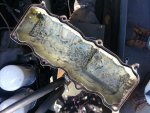Well, its been about 3 months since I got the rebuild done and I'm not completely satisfied. New pistons,rings, sleeves, NOS heads, New style head gaskets and I still have blow-by coming out of my slobber tube. I also have some thick grease looking stuff on the bottom of my oil fill cap and inside the valve cover. I also seem to be losing coolant somehow and I don't know where it is going. My oil is not milky or increasing the level, so I'm not sure. I have the pump turned up pretty good and can get over 15PSI of boost, so I don't know if its a blown head gasket or what. I did a leakdown test last night and the numbers seem to be all over the place and I don't really trust that data because when i roll the engine over a little with the leak down test in progress, I can change the numbers a little bit after I stop turning the crank slightly (its hard to explain). I also did a compression check since I was right there and I got all around 340 PSI on 4 of the 6 cylinders. I didn't get a chance to check the other 2 because my copper sealing washer got stuck in one of the holes and i couldn't get it out. I was frustrated working in low light and not being able to get the sealing washer out, I needed to call it a night. I throw all this money at it in new parts because I wanted the best running Deuce and not have to work on it for a long time... and it still is not 100%. I would ask for advise but I'm really dont know what else it could be.
EGT's are a higher than they were at first as well. I can run hot just empty and it never used to be like that right after the rebuild. So that is an indication something is not right. I can get up to 1150 pulling away from a light if I take off as fast as I can. I never adjusted the fuel rate at any time before or after the rebuild, so not sure what is going on. I am not thinking that is the cause of the problem.
The only possible theory I can think of is that one of my head gaskets is leaking. When I put the head gaskets on, I used the copper spray gasket on the new gaskets. The stuff is made by Permatex. I'm sure you guys have experience using it. When I did gaskets before, I did not use the copper spray gasket stuff and put them on dry. That is the only difference. I'm at a loss on where to go. Next step I guess is bring it in the garage and loosen all of the valves and do another leakdown test where I know all of the valves are shut and see if I get any different numbers. Maybe pressurize the cooling system with 7 PSI while I am at it. I only started loosing coolant after the rebuild, so I doubt it is my oil cooler because I never touched that.
Opinions welcome I guess. I'm just so mad at the thing I almost could care less about fixing it.


